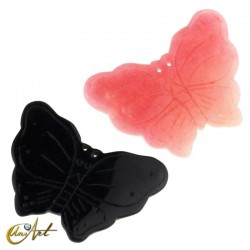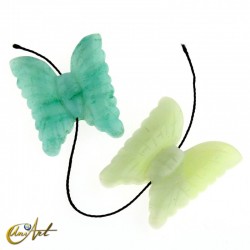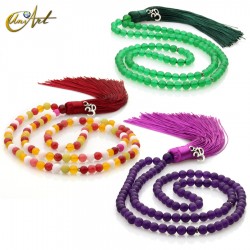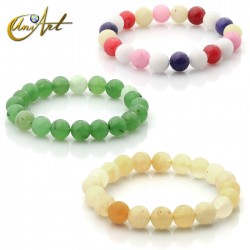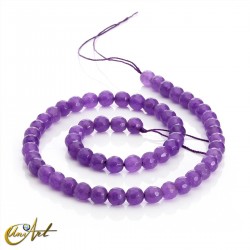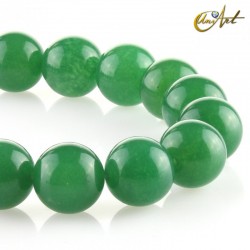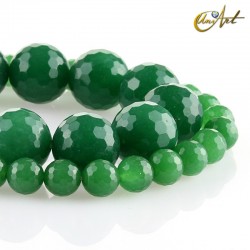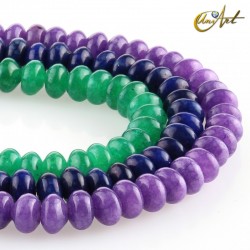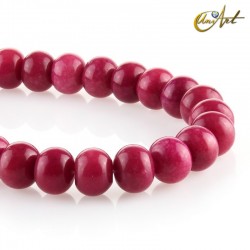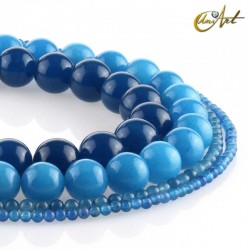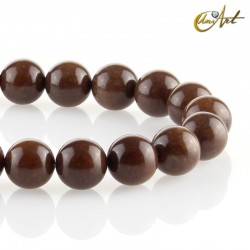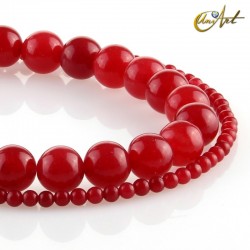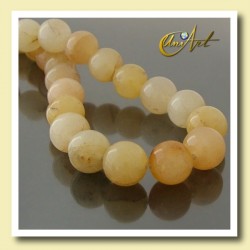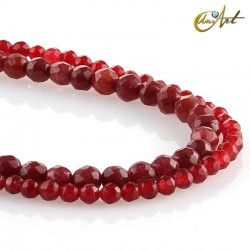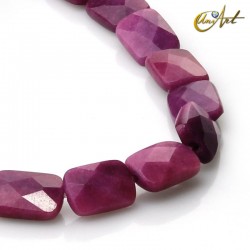The Fascinating World of Jade
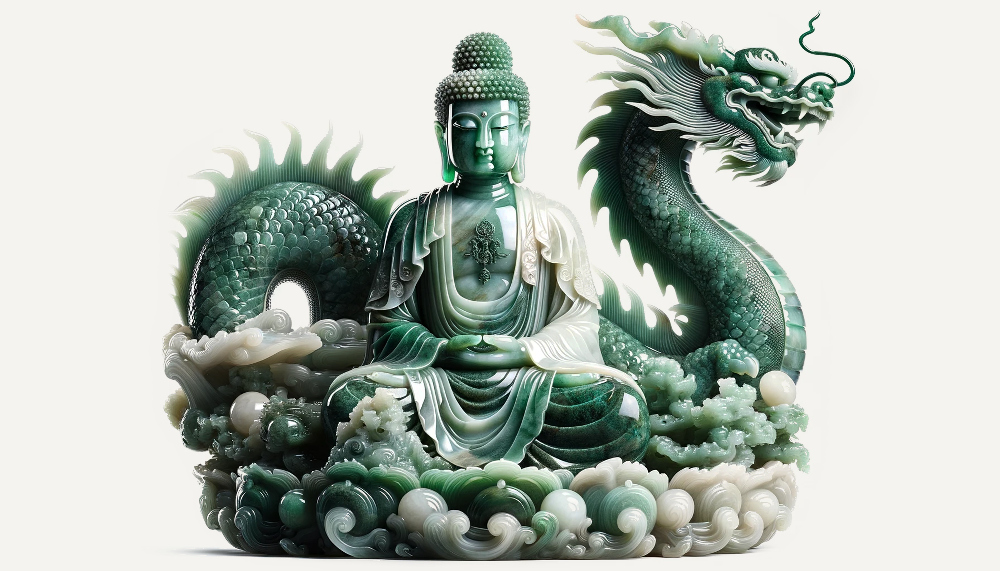
Jade, one of the most revered gemstones throughout history, is renowned both for its ethereal beauty and its deep cultural significance. In this article, we will explore the various facets of jade, from its composition to its history, varieties, and much more.
Physical and Chemical Properties of Jade
What is Jade?
The term "jade" generally refers to two distinct minerals: jadeite and nephrite. Both are silicates, but they differ in composition and crystal structure. Jadeite is a silicate of sodium and aluminium, while nephrite is a silicate of calcium and magnesium. These differences influence their physical properties and appearance.
Detailed Characteristics of Jadeite and Nephrite
Jadeite
- Hardness: Between 6.5 and 7 on the Mohs scale.
- Colour: Displays a wide range of colours, including green (from very pale to intense emerald green), blue, lavender, pink, and white. The intense green, often called "imperial jade", is particularly valued.
- Crystal Habit: Generally forms in granular or fibrous crystals, giving it a dense and compact structure. This structure results in greater translucency and exceptional lustre.
- Translucency: Varies from semi-transparent to opaque.
Nephrite
- Hardness: Between 6 and 6.5 on the Mohs scale.
- Colour: Commonly found in shades of green, but can range from creamy white to dark green. The colours are generally more subdued compared to jadeite.
- Crystal Habit: Comprises interlocking fibres at the microscopic level, which gives it extraordinary toughness, making it extremely resistant to breaking and impacts.
- Translucency: Mainly opaque, with a more waxy appearance and less lustre than jadeite.
These differences mean that jadeite is often more valued for its translucency and variety of vibrant colours, while nephrite is appreciated for its exceptional strength and toughness. Each type of jade has its own beauty and unique features that make them desirable for different applications, from jewellery to works of art.
Main Deposits
Jade is primarily found in Myanmar (Burma), where the highest quality jadeite is mined. Other significant deposits include Guatemala (nephrite), New Zealand (nephrite), and Russia (nephrite). The quality of jade varies depending on its origin, influencing its value and appearance.
Etymology and History of Jade
Origin of the Name "Jade"
The word "jade" comes from the Spanish term "piedra de ijada", historically used to describe its use in treating kidney ailments. This terminology reflects the high esteem that ancient Mesoamericans held for this gem, valuing it as a "stone of the flank" for its supposed healing properties.
Origin of the Name "Nephrite"
The term "nephrite" comes from the Greek "nephros", meaning "kidney". This name is also due to the ancient belief that this stone had the ability to cure kidney diseases and related ailments. Its use in this sense reflects the historical connection of nephrite with medicine and healing, similar to the beliefs associated with jadeite.
Cultural History and Legends of Jade
In Mesoamerica
Among the Maya and Aztecs, jade was extremely valued, often more so than gold. The Maya regarded jade as a symbol of life and fertility, and used it in religious rituals and as funerary offerings for the nobility. They believed that jade could open the path to the underworld and connect with the gods. On the other hand, in Aztec culture, jade symbolised water and vegetation, being central in rituals seeking to ensure rains and good harvests.
In Asia
In China, jade is known as "yu" and has been valued for millennia, being considered a symbol of purity, morality, and authority. It was believed that jade had life-prolonging properties, and it was common to see it in ritual objects and imperial adornments. Additionally, jade figures were placed in the mouths of the deceased, as part of a ritual to ensure immortality.
Jade and Buddhism
In Buddhism, jade is highly revered, especially in China and other East Asian countries. It is associated with virtue and morality, being a symbol of the Buddhist principles of compassion and wisdom. Statues of Buddha and other religious icons are often carved in jade, reflecting its sacred status and connection to spiritual enlightenment.
Greek Influence
While jade was not common in ancient Greece, its name, "nephrite", reflects Greek influence in its medicinal perception. The Greeks believed in the healing properties of certain stones, and this belief extended to jade when it reached Europe through trade routes.
Pounamu and the Legend of Taniwha Poutini (Jade in New Zealand)
Pounamu, also known as New Zealand greenstone, holds a special place in Maori culture and traditions. This stone is known not only for its beauty and durability but also for its deep cultural significance. One of the most famous legends associated with Pounamu is that of Taniwha Poutini. According to this story, Poutini is a taniwha (a supernatural being in Maori mythology) that protects the people and lands of southern New Zealand. The legend tells that Poutini kidnapped Waitaiki, a beautiful married woman, and took her south. To escape from Waitaiki's husband, who was pursuing them, Poutini transformed the woman into jade and hid her in the waters of the Arahura River. This legend not only explains the origin of Pounamu but also connects it with themes of protection, love, and transformation. Pounamu is highly valued by the Maori and is used in the creation of tools, weapons, and jewellery. Moreover, it symbolises peace, harmony, and respect, and is considered a taonga (treasure). This stone is traditionally passed down from generation to generation, carrying with it stories, traditions, and the essence of the land and Maori culture.
These stories and legends underline the universal fascination with jade, revealing not only its beauty and rarity but also its profound significance in various cultures. From prestige and power in China to spiritual rituals in Mesoamerica, and its connection to enlightenment in Buddhism, jade remains a stone of great cultural and spiritual importance.
Famous Works and Antiquities in Jade
Jade has been used in some of the most remarkable works of art and historically significant objects across various cultures. Noteworthy examples include:
In China
- The Jade Relics of Sanxingdui: Unearthed at the Sanxingdui archaeological site in China, these artefacts are a testament to ancient skill in jade craftsmanship and its significance in rituals and offerings.
- The Bi Disk: A ceremonial Chinese object, the Bi disk is a symbol of the heavens. Made from jade, its use dates back to ancient times and is a fundamental element in Chinese culture and art.
In Mesoamerica
- The Tomb of King Pakal at Palenque: The Mayans decorated the tomb of this great king with jade, including a famous jade funeral mask covering his face. This mask, composed of hundreds of jade pieces, reflects the high regard in which this culture held the stone.
- Jade Sculptures by Contemporary Chinese Artists: Many modern artists have continued the tradition of carving jade, creating works that blend traditional techniques with contemporary styles.
These pieces not only demonstrate the skill and creativity of artisans through the ages but also reflect the importance and symbolic value that different cultures have attributed to jade. From ritual objects to works of art, jade remains a treasured material that connects the past with the present.
Through jade, a timeless stone, we can perceive an uninterrupted connection with our ancestors, their lives, and their cultures. This stone, having witnessed empires rise and fall, ancient rituals, and the evolution of art, endures as a powerful symbol of the durability and permanence of human history.
Jade in Esotericism
Symbolism and Energy of the Jade Stone
In esotericism, jade is highly valued for its connection with nature and vital energy. It is believed that this gem possesses protective and purifying properties, capable of repelling negative energies. Likewise, jade is considered a symbol of serenity, wisdom, and balance.
Jade's Connection with the Chakras
Jade is frequently associated with the heart chakra, the energy centre related to love and compassion. It is thought that wearing jade can help balance this chakra, promoting feelings of peace, harmony, and emotional understanding.
Use of Jade in Meditation and Spiritual Practices
In meditation, jade is used as a tool to foster connection with the earth and nature. Holding jade during meditation is believed to enhance introspection and self-knowledge. Furthermore, it is commonly used in spiritual practices seeking emotional healing and the strengthening of intuition.
Jade and the Attraction of Good Fortune
Many cultures consider jade a bearer of good luck and prosperity. In esotericism, this stone is used with the intention of attracting abundance and success in different aspects of life, from professional to personal.
Jade in Rituals
In some esoteric rituals, jade is used for the consecration of spaces and objects. Its purifying energy is ideal for cleansing environments of stagnant or negative energies, creating a space of harmony and balance.
Influence on Emotional and Physical Well-being
Jade is believed to have a calming effect on the mind and body, helping to reduce stress and anxiety. Additionally, in gem therapy, this gem is used to alleviate pain and improve overall physical well-being.
In summary, in the esoteric realm, jade is much more than a beautiful stone; it is a powerful tool for healing, protection, and promoting holistic well-being. Its ancient history and presence in various cultures complete its mysticism and spiritual appeal, making it a preferred gem in many contemporary esoteric practices.
Usos del Jade en Joyería e Industria
Joyería (Joyas de Jade)
El jade ha sido una piedra preciosa muy apreciada en la joyería durante milenios. Se utiliza en todo, desde intrincados tallados hasta elegantes cabujones en anillos, collares y pulseras. Su durabilidad y gama de colores lo hacen versátil y deseado.
Uso Industrial (Cuentas y Abalorios de Jade)
En la industria moderna de la joyería, el jade se utiliza de manera extensiva para crear cuentas y otros elementos decorativos. Una práctica común en este ámbito es teñir el jade para obtener una variedad de colores vibrantes, como rosa, azul, verde y morados. Este proceso permite adaptar el jade a las tendencias actuales de la moda y satisfacer la demanda de piezas de joyería coloridas y atractivas.
Tipos de Jade Utilizados para Cuentas
El jade utilizado para hacer cuentas a menudo es de variedades menos costosas, principalmente porque el proceso de teñido no requiere las calidades más altas del mineral. Tanto la jadeíta como la nefrita pueden ser teñidas, pero es más común encontrar nefrita debido a su disponibilidad y costo más accesible.
Proceso de Teñido
- Selección y Preparación: Se seleccionan piezas de jade adecuadas, las cuales son limpiadas y pulidas para prepararlas para el teñido.
- Teñido: El jade se sumerge en soluciones de colorantes. Este proceso puede variar en duración, dependiendo de la intensidad del color deseado. Algunas técnicas pueden incluir el calentamiento de la solución para permitir una mejor absorción del color.
- Fijación del Color: Después del teñido, el jade se trata para fijar el color. Esto puede implicar un proceso de calentamiento o el uso de otras sustancias químicas para asegurar que el color sea duradero.
- Pulido Final: Una vez teñido y fijado el color, el jade se pule nuevamente para realzar su brillo y resaltar el color.
Consideraciones sobre el Jade Teñido
Es importante señalar que el jade teñido ofrece una opción accesible y versátil para la joyería contemporánea, permitiendo a los diseñadores explorar una amplia gama de estilos y preferencias de color.
Uses of Jade in Jewellery and Industry
Jewellery (Jade Jewellery)
Jade has been a precious gemstone highly valued in jewellery for millennia. It is used in everything from intricate carvings to elegant cabochons in rings, necklaces, and bracelets. Its durability and range of colours make it versatile and desired.
Industrial Use (Jade Beads and Ornaments)
In the modern jewellery industry, jade is extensively used to create beads and other decorative elements. A common practice in this field is to dye jade to achieve a variety of vibrant colours, such as pink, blue, green, and purple. This process allows jade to be adapted to current fashion trends and meet the demand for colourful and attractive jewellery pieces.
Types of Jade Used for Beads
The jade used to make beads is often of less expensive varieties, mainly because the dyeing process does not require the highest qualities of the mineral. Both jadeite and nephrite can be dyed, but nephrite is more commonly found due to its availability and more accessible cost.
Dyeing Process
- Selection and Preparation: Suitable pieces of jade are selected, which are cleaned and polished to prepare them for dyeing.
- Dyeing: The jade is immersed in dye solutions. This process can vary in duration, depending on the desired colour intensity. Some techniques may include heating the solution to allow better colour absorption.
- Colour Fixation: After dyeing, the jade is treated to fix the colour. This may involve a heating process or the use of other chemicals to ensure the colour is durable.
- Final Polishing: Once dyed and the colour fixed, the jade is polished again to enhance its shine and highlight the colour.
Considerations on Dyed Jade
It is important to note that dyed jade offers an accessible and versatile option for contemporary jewellery, allowing designers to explore a wide range of styles and colour preferences.


